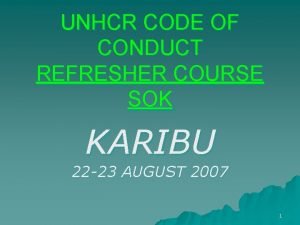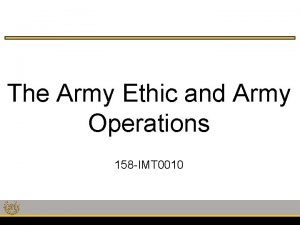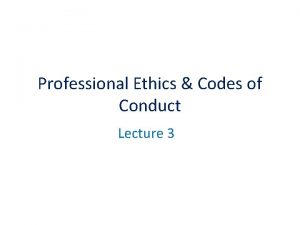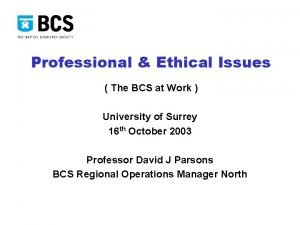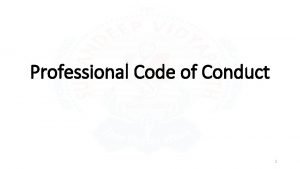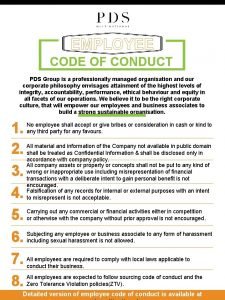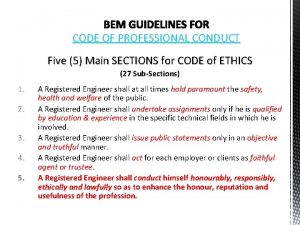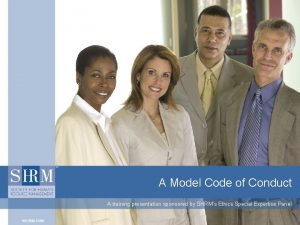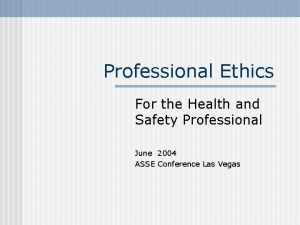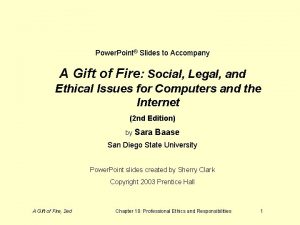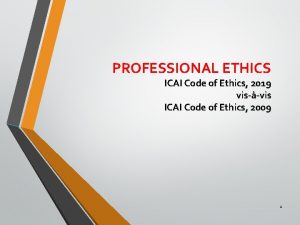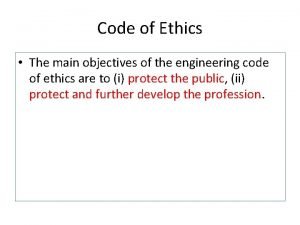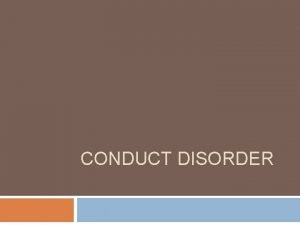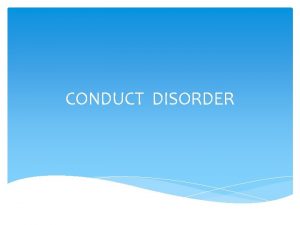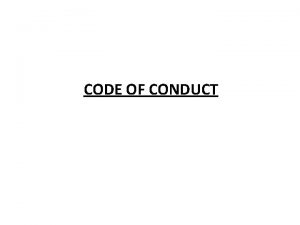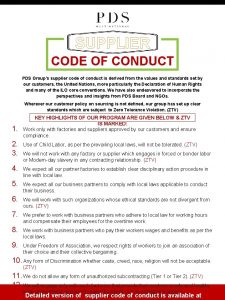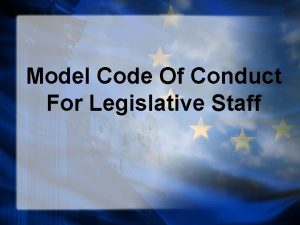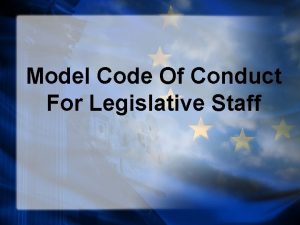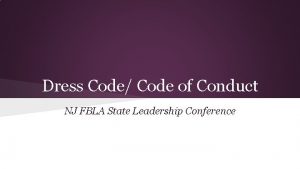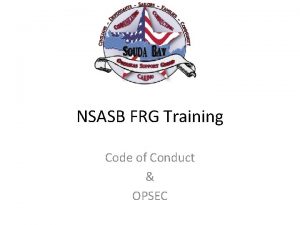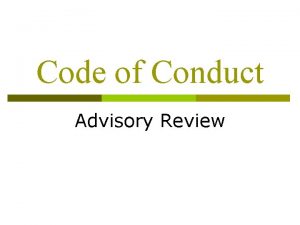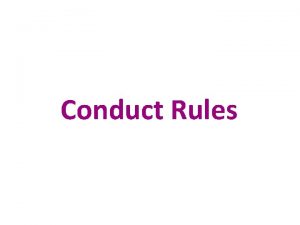Code of Conduct An Introduction to the Code




















- Slides: 20

Code of Conduct An Introduction to the Code of Conduct

“ELIAS” Problems 4 discrete problems “hidden” in the overall diet of skills assessments. Each problem will receive a mark out of 10. Will be marked non-competent, very competent etc. Failure results in having to take an end of year MCT on ethics.

Code of Conduct Consists of: (a) Code of Conduct “Proper” (b) Annexes (c) Written Standards for the Conduct of Professional Work (d) “Guidance” to be found on the Bar Standards Board website (www. barstandardsboard. org. uk)

Code of Conduct Why have a Code? What is a “Profession”? What is “Professionalism”?

Fundamental Principles To the Court See 302 in the Code of Conduct “Proper”: “A barrister has an overriding duty to the Court to act with independence in the interests of justice: he must assist the Court in the administration of justice and must not deceive or knowingly or recklessly mislead the Court. ”

Fundamental Principles To the Lay Client See 303 (a) – “A barrister: …must promote and protect fearlessly and by all proper and lawful means the lay client's best interests and do so without regard to his own interests or to any consequences to himself or to any other person (including any professional client or other intermediary or another barrister)”

Fundamental Principles See 702 - “Whether or not the relation of counsel and client continues a barrister must preserve the confidentiality of the lay client's affairs and must not without the prior consent of the lay client, or as permitted by law, lend or reveal the contents of the papers in any instructions to or communicate to any third person … information which has been entrusted to him in confidence or use such information to the lay client's detriment or to his own or another client's advantage. ”

Fundamental Principles See 305. 1 – “A barrister must not in relation to any other person (including a client or another barrister or a pupil or a student member of an Inn of Court) discriminate directly or indirectly or victimise because of race, colour, ethnic or national origin, nationality, citizenship, sexual orientation, marital status, disability, religion or political persuasion. ”

Fundamental Principles See 306 “A barrister is individually and personally responsible for his own conduct and for his professional work: he must exercise his own personal judgement in all his professional activities. ”

Question 1 You are defending a case involving a client who pleaded guilty to a charge of aggravated burglary on the day his trial was due to commence. In passing sentence the judge applies a discount of 1/3 to his custodial sentence due to your client’s guilty plea. You are aware that the Sentencing Guidelines Council’s most recent guidance (which is binding on all sentencers) stipulates that the maximum discount in such circumstances should not be 1/3 but 1/10. Prosecuting counsel does not raise this point with the judge. What should you do?

Question 1 - Answer Guide See 302 & 303(a) outlined earlier. See 708(c) and also 5. 10(c) of the “Written Standards” Also note 5. 5 of the “Written Standards” – be polite!

Question 2 You are instructed to represent a defendant who is charged with assault occasioning Actual Bodily Harm. When interviewed, he denied the offence and claimed that he had been wrongly identified. He was arrested at the scene and identified by the victim during a formal ID procedure. In conference, the Defendant admits to you that he was responsible for the assault but refuses to countenance a guilty plea. He intends to deny it and claim that the police arrested the wrong person. What should you do?

Question 2 – Answer Guide See 302 and 303(a) outlined earlier See, in particular, 12. 1 to 12. 6 of the “Written Standards” Also see 606. 1

Question 3 You are instructed on behalf of a Defendant who is charged with assault. The Defendant is a member an extreme political organisation whose views you detest. The alleged assault occurred at a rally of that organisation where the Defendant supposedly got into a fight with a journalist. Assume you have the time and expertise to deal with the case. Can you turn down the brief?

Question 3 – Answer Guide See 601 & 602 (known as the “cab rank” rule).

Question 4 You are a barrister with a thriving criminal practice. You are instructed by a firm of solicitors, who frequently send you work, to represent a client charged with murder. From reading through the brief it seems quite a complex case, and you are already working as hard as you are able on a number of other criminal trials. It is unlikely that you would be able to prepare and conduct this case properly due to your busy schedule. What should you do?

Question 4 – Answer Guide See 603 for some exceptions to the “cab rank” rule. See 610 as to how the return of instructions should be handled.

Question 5 You are acting for a client in a personal injury claim. You receive instructions to write an opinion on liability and quantum. One of the issues in the brief is the fact that the client is statute-barred with regard to the limitation period of 3 years under the Limitation Act 1980. From the papers solicitors indicate that they think will client will get the benefit of the court’s discretion to allow the claim nonetheless. However it is your judgement that the chances of the court exercising its discretion to allow the client to sue the defendants are slim. You think there is a good case for negligence against the instructing solicitors for not pursuing the claim as expeditiously as they should. What should you do?

Question 5 – Answer Guide See 306, 307(c) & 5. 3 of the “Written Standards” See 303(a) and 303(b) See 3. 3 and 5. 1 of the “Written Standards” See 703

Code of Conduct Conclusion
 Iosh my cpd
Iosh my cpd Unhcr code of conduct
Unhcr code of conduct Pow code of conduct
Pow code of conduct Tlo army
Tlo army Acm ethics behavior
Acm ethics behavior British computer society code of conduct
British computer society code of conduct Code of conduct professional ethics
Code of conduct professional ethics Code of conduct military
Code of conduct military Employee code of conduct policy
Employee code of conduct policy Project management code of conduct
Project management code of conduct Code of conduct articles
Code of conduct articles Code of ethics bem
Code of ethics bem Aalto code of conduct
Aalto code of conduct Code of conduct training ppt
Code of conduct training ppt Asse code of conduct
Asse code of conduct Cips code of ethics and professional conduct
Cips code of ethics and professional conduct Kitchen code of conduct
Kitchen code of conduct Icai code of conduct
Icai code of conduct Astrazeneca code of conduct
Astrazeneca code of conduct Engineering code of conduct
Engineering code of conduct Professional ethics presentation
Professional ethics presentation

